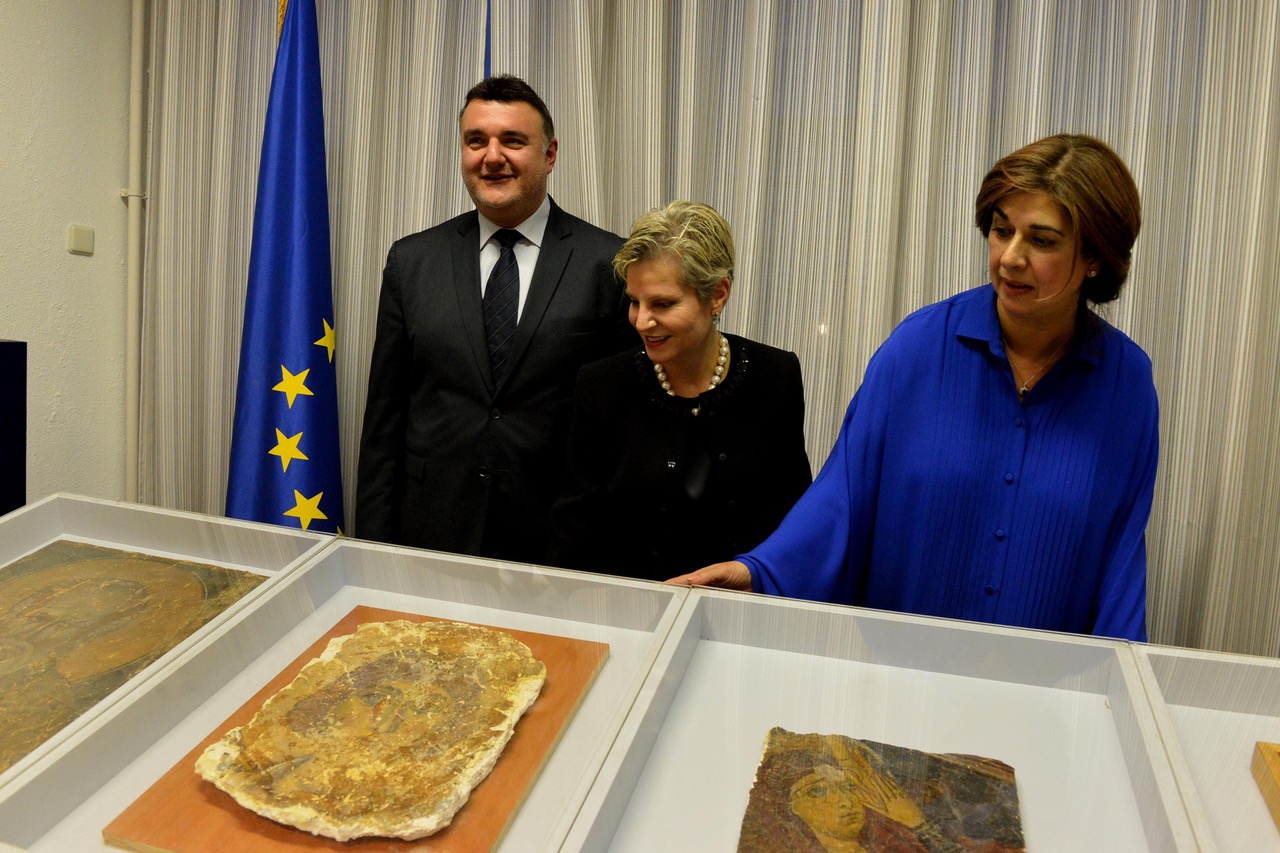At a special ceremony held at the Embassy of Cyprus in The Hague on 21 January, Walk of Truth Foundation delivered to Cyprus four fragments of frescoes that had been looted after the 1974 Turkish invasion, then illegally traded on the world art market before they were returned by a Canadian art collector several decades later.
Acting on a tip from the antiquities trade, Tasoula Hadjitofi, the founder of Walk of Truth, approached the collector informing him that his frescoes were looted. Hadjitofi didn’t know exactly what he had in his possession, and was surprised when four frescoes were delivered to her London hotel room by Fedex in 2014. The collector’s only conditions were that he wished to remain anonymous and that the frescoes should return to their rightful owner. The frescoes have since been restored and stabilized for travel at the foundation’s own expense, then kept in specially designed storage.
The Cypriot Minister of Transport, Communications and Works, Vassiliki Anastassiadou, accepted the frescoes on behalf of the President of the Republic. In her speech, the Minister thanked Walk of Truth and its founder, Tasoula Hadjitofi, for her efforts to the repatriate stolen cultural treasures and expressed her government’s commitment to support such well-intentioned efforts.
Delivering the frescoes to the Minister, Hadjitofi pointed out that repatriation entails collaboration of various bodies on the basis of mutual trust. By founding Walk of Truth, she said, she succeeded in building a network of trust involving prominent personalities, jurists, politicians, archaeologists and ordinary people in a bid to protect cultural heritage on an international level. With the same trust shown in her by all, she said, she delivers the four frescoes to the Minister so that she may deliver them to the Cyprus people.
“We are delighted that these fragments of frescoes are returning home, more than 40 years after they were illegally removed. Their story is one of violence, loss and displacement – a narrative they share with refugees from war. The beginning of their long journey home is a cause for celebration. Every item repatriated is a piece of Cypriot heritage and identity recovered for future generations.”
Two of the four frescoes have been identified as belonging to the church of Panagia Apsinthiotissa, a Greek Orthodox monastery situated in the northern occupied part of the island. Probably established in the eleventh or twelfth century as a Byzantine imperial foundation, the monastery was named after the absinthe, or wormwood, that grew there. After the Ottoman conquest, the monastery became the property of the Greek Orthodox Patriarchate of Jerusalem and has remained under its spiritual jurisdiction ever since. The church was partly destroyed in the eighteenth century, but a few of its frescoes survived. Two of the frescoes to be repatriated depict the Virgin Mary attending the Deposition of Christ, and an image of a Martyr.
The third fresco in all likelihood originates from the Church of Panagia in occupied Assia, while the provenance of the fourth remains unknown. “It is unusual for holders of looted antiquities to relinquish them voluntarily,” Hadjitofi says. “We are grateful to this collector for his generosity.” Sadly, the Apsinthiotissa frescoes cannot return to the church from which they were stolen. In the meantime, they have served as cultural ambassadors for Cyprus, as they were exhibited in the U.K. House of Lords in the context of a debate about cultural heritage destruction in conflict zones. It is our hope that they will now be displayed in a context that restores them to their original role as part of a religious experience, given that Greek Orthodox Christians traditionally view icons, frescoes and mosaics as a window into the Heavenly Kingdom.
In his speech at the event, Dr Willy Bruggeman, President of the Belgian Federal Police Board, and member of the Board of the Walk of Truth, pointed out the following: “The prevailing wisdom today is that illegal excavation and trade in archaeological objects is destroying our world cultural heritage. The illicit antiquities trade is nowadays estimated to be a $4 billion enterprise; however, UNESCO suggests that the number may be closer to $6 billion. In general, plunder of antiquities during and following military and other conflicts is by no means a recent phenomenon. Several studies, both ongoing and published, link antiquities traffickers to a range of serious crimes, including terrorism, corruption, money laundering, prostitution, the smuggling of drugs and, nowadays, even more and more to organised crime in general.”
He also wondered: “Why is Walk of Truth (and Cultural Crime Watchers worldwide) so important and what makes it unique and specific? It is unique because the activities of this NGO as a non-profit organisation are based on strict ethical rules. It is specific because Walk of Truth is not only bringing looted art back home, as we see today, but is also campaigning against the problem of art trafficking. Walk of Truth and its partners are also effective because they lobby for legislative change: we have been listened to and have been successful in changing legislations in Holland, the UK and in influencing policies at EU level.”
David Burrowes, a politician and former British MP, a friend of Cyprus, referred to the event titled ‘Blood, Treasure and Islamic State: War, Extremism and the Looting of Culture’ held in 2014 at the House of Lords in England, where the four frescoes had been exhibited in the presence of parliamentarians, and experts in the field of cultural heritage and trafficking of illicit art. The event, Mr Burrowes said, resulted in political pressure for action which, on 12 September 2017, led to the United Kingdom officially becoming party to the Hague Convention for the Protection of Cultural Property.
Speaking on behalf of the Church of Cyprus and the Patriarchate of Jerusalem, Bishop Porfyrios of Neapolis thanked Walk of Truth and its founder, Tasoula Hadjitofi, for the delivery of the four frescoes.



2disreputable
3likewise
get help with dissertation https://professionaldissertationwriting.org/
edd dissertation topics https://professionaldissertationwriting.com/
what is a dissertation paper https://helpwithdissertationwritinglondon.com/
dissertation writing services in usa https://dissertationwritingcenter.com/
powerpoint for creative writing https://dissertationhelpexpert.com/
proposal and dissertation help 3000 words https://accountingdissertationhelp.com/
defending dissertation https://examplesofdissertation.com/
rfp writing services https://writing-a-dissertation.net/
writing editing service https://bestdissertationwritingservice.net/
help with dissertation https://businessdissertationhelp.com/
best dissertation writing services uk https://customdissertationwritinghelp.com/
custom dissertation writing https://writingadissertationproposal.com/
dissertation proposal writing service https://dissertationhelpspecialist.com/
buy the help https://dissertationhelperhub.com/
dissertation help online https://customthesiswritingservices.com/
online casino royal https://download-casino-slots.com/
best online casino real money https://firstonlinecasino.org/
caesars online casino customer service phone number https://onlinecasinofortunes.com/
online casino no deposit https://newlasvegascasinos.com/
el royale online casino review https://trust-online-casino.com/
wild vegas online casino https://onlinecasinosdirectory.org/
borgata online casino app https://9lineslotscasino.com/
casino game online https://free-online-casinos.net/
best no deposit bonus online casino https://internet-casinos-online.net/
real money casino online https://cybertimeonlinecasino.com/
online casino no verification withdrawal usa https://1freeslotscasino.com/
online casino with free sign up bonus https://vrgamescasino.com/
casino live online https://casino-online-roulette.com/
online casino bitcoin https://casino-online-jackpot.com/
online casino keno https://onlineplayerscasino.com/
online casino real money california https://ownonlinecasino.com/
new online casino no deposit https://all-online-casino-games.com/
gta online casino https://casino8online.com/
avast vpn buy https://freevpnconnection.com/
best vpn router 2022 https://shiva-vpn.com/
express vpn download https://freehostingvpn.com/
best vpn for downloading https://ippowervpn.net/
online vpn https://imfreevpn.net/
windscribe free vpn https://superfreevpn.net/
vpn ratings https://free-vpn-proxy.com/
free vpn for chromebook https://rsvpnorthvalley.com/
free gay dating sites grindr https://gay-singles-dating.com/
gay dating apps military man imposter https://gayedating.com/
xxx dating sim gay https://datinggayservices.com/
dating sites for totally free for usa https://freephotodating.com/
free dating site for ladys https://onlinedatingbabes.com/
dating simulator https://adult-singles-online-dating.com/
free online dating sites with no fees https://adult-classifieds-online-dating.com/
top free dating sites https://online-internet-dating.net/
ourtime login https://speedatingwebsites.com/
free dating site chatting https://datingpersonalsonline.com/
farmersonly https://wowdatingsites.com/
ourtime inloggen https://lavaonlinedating.com/
date online https://freeadultdatingpasses.com/
free dating apps no fees https://virtual-online-dating-service.com/
find online dating https://zonlinedating.com/
singles online dating https://onlinedatingservicesecrets.com/
riversweeps online casino app download https://onlinecasinos4me.com/
casino games free online play https://online2casino.com/
play online casino for real money https://casinosonlinex.com/
free gay chat line phone numbers https://newgaychat.com/
gay masturbation chat https://gaychatcams.net/
line group chat gay tampa https://gaychatspots.com/
gay priest chat https://gay-live-chat.net/
chat de gay usa https://chatcongays.com/
free gay chat avenue #1 https://gayphillychat.com/
gay advise chat https://gaychatnorules.com/
gay sex chat roulette https://gaymusclechatrooms.com/
free live gay web cam chat rooms https://free-gay-sex-chat.com/
free gay chat lines in fitchburg,ma https://gayinteracialchat.com/
black bottom gay chat room https://gaymanchatrooms.com/
buy psychology papers https://term-paper-help.org/
write my psychology paper https://sociologypapershelp.com/
will you write my paper for me https://uktermpaperwriters.com/
help with filing divorce papers https://paperwritinghq.com/
pay for someone to write your paper https://writepapersformoney.com/
writer paper https://write-my-paper-for-me.org/
custom papers review https://doyourpapersonline.com/
order a paper online https://top100custompapernapkins.com/
custom handwriting paper https://researchpaperswriting.org/
paper writers online https://cheapcustompaper.org/
write my paper in 3 hours https://writingpaperservice.net/
write my business paper https://buyessaypaperz.com/
write my sociology paper https://mypaperwritinghelp.com/
what is the best paper writing service https://writemypaperquick.com/
find someone to write my paper https://essaybuypaper.com/
paper writing service reviews https://papercranewritingservices.com/
help with a paper https://premiumpapershelp.com/
order custom paper https://ypaywallpapers.com/
where to buy college papers https://studentpaperhelp.com/
2brooded
do my coursework https://brainycoursework.com/
help with coursework https://courseworkninja.com/
online coursework https://writingacoursework.com/
cpa coursework https://mycourseworkhelp.net/
coursework research https://courseworkdownloads.com/
coursework questions https://courseworkinfotest.com/
data analysis coursework https://coursework-expert.com/
coursework support https://teachingcoursework.com/
creative writing coursework ideas https://courseworkdomau.com/
hinge dating https://freewebdating.net/
find my dating https://jewish-dating-online.net/
singles to meet https://free-dating-sites-free-personals.com/
free online sex dating websites https://sexanddatingonline.com/
12 single dating site https://onlinedatingsurvey.com/
dating best sites https://onlinedatingsuccessguide.com/
senior dating sites free https://onlinedatinghunks.com/
best online dating websites https://datingwebsiteshopper.com/
online dating sites for free 100% https://allaboutdatingsites.com/
free online sating https://freedatinglive.com/
aduilt dating https://freewebdating.net/